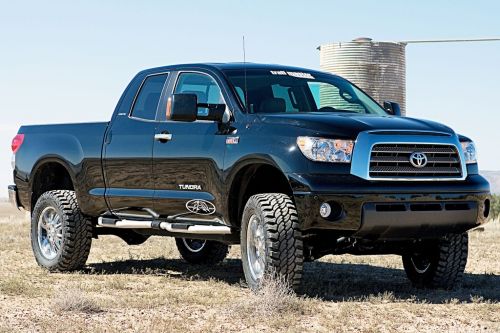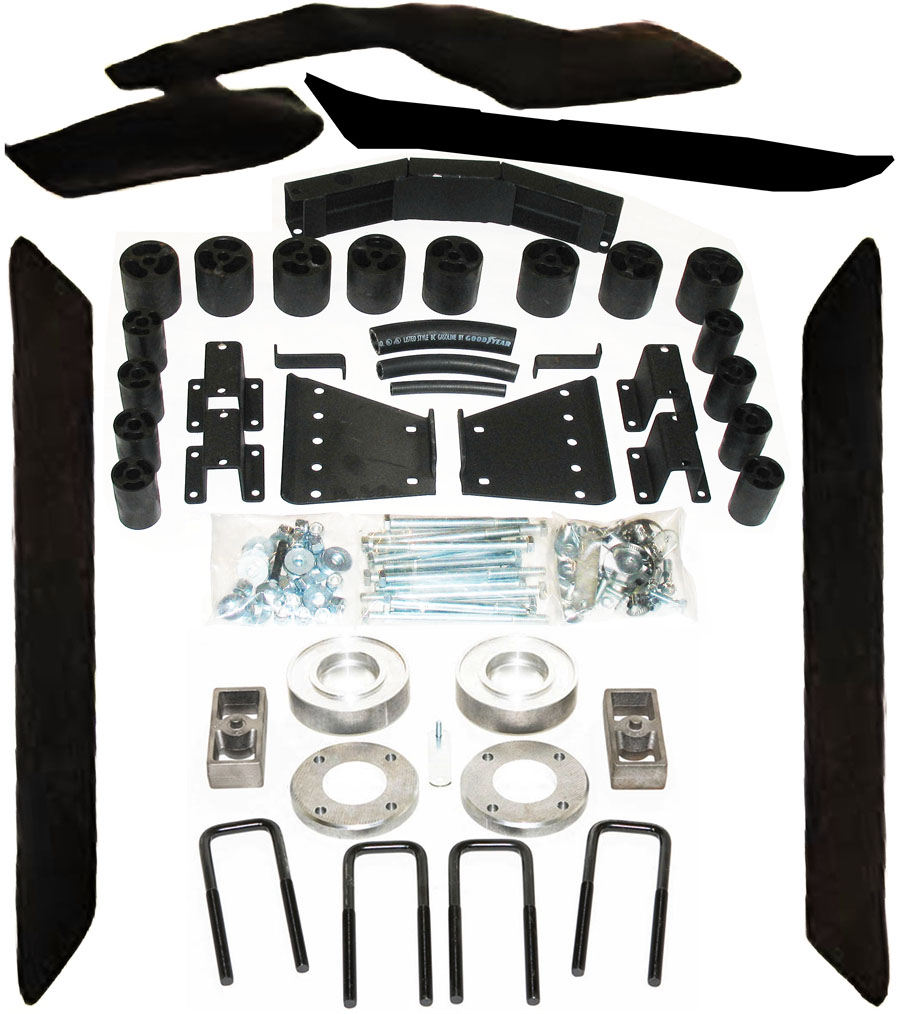The Performance Accessories Premium Body Lift Kit for the Toyota Tundra
Benjamin | Sep 20, 2012 | Comments 7
Toyota Tundra owners are faced with a huge number of options when it comes to adding a lift kit to their truck. What a lot of Tundra fans quickly realize is that some lift kits are a lot more involved than others in terms of the modifications that are required to the vehicle’s suspension system. Aggressive lift kits have their place in the Tundra world, especially amongst drivers who need to negotiate difficult off-road conditions on a regular basis, but what about those who simply want to add a set of bigger wheels and tires without dramatically altering how their pickup drives?

The Perfomance Accessories lift installed.
That’s where body lift kits like the Performance Accessories Premium Lift System comes in. Compatible with most versions of the current generation Tundra (whether two-wheel or four-wheel drive), the Premium Lift System gives buyers the increased body height they need to run 35-inch tires without making any real changes to the vehicle’s stock suspension system.
How Does It Work?
Unlike many other lift kit options, the Performance Accessories Premium Lift System actually raises the body of the Toyota Tundra without touching the vehicle’s suspension components. This means that the installation process is a little more involved than one might expect, as the instructions that come with the kit detail a long list of wiring connectors, hoses, engine bay components (including the air intake and power steering system) that must be disconnected in order to not interfere with the actual lift. You’ll also notice that the kit comes with a set of bumper brackets to help relocate the front and rear bumpers that you’ll be taking off and repositioning during the install.

A look at what you get in the Premium Lift System Kit.
Performance Accessories recommends that you use a hydraulic jack and a wood block in order to raise the cab one side at a time, taking care to ensure that no hoses or lines are snagged or stuck in such a way that they can’t flex while the body is lifted. Each side of the cab is then supported by new nylon-reinforced blocks that come with the kit, giving it the three inches of additional space that allow for the use of oversized tires.
The same process takes place in order to raise the Tundra’s cargo bed after the mounting bolts have been loosened on each side. Performance Accessories notes that it’s a good idea to measure out the spacing between the box and the cab as well as between each bumper and the body prior to undertaking the installation so that you have a reference to work with when putting everything back on. Note that you’ll have to trim the bottom of the bumper in order to remount it properly.
The kit also comes with mounting brackets to help you relocate the parking brake cable, radiator, and fuel filler, as well as an extension for the steering shaft. Gap guards that help to conceal the space that has opened up inside the fender wells between the Tundra’s body and frame are included with the Premium Lift System, as are coil and strut spacers that limit preload.
Why Go Through All This Trouble?
After reading through all of that – or even just checking out the Premium Lift System’s set of instructions – it might seem like installing a body lift kit is a lot of trouble to go through versus simply slapping on a suspension lift and calling it a day. There are three compelling reasons for choosing the Performance Accessories kit over a traditional lift.
- Driving feel – your truck is going to look taller without really driving any taller, and while you will notice a difference in handling thanks to your bigger tires and slightly higher center of gravicy, you won’t have to deal with any out-of-factory spec suspension behavior as a result of this kit. This also helps to reduce the stress on your stock suspension and driveline components.
- The Premium Lift System is also fairly cheap, coming in at between $600 and $900 depending on where you shop. This makes it more affordable than some of its competitors, and although you will have to spend some quality time with your truck during the installation process you won’t have to spring for any special tools or pay a mechanic to tackle the job for you, which further saves on cost.
- You can combine a body lift with a standard 3″ lift to get a total of 6″ of lift, but it’s less expensive that most 6″ bracket lift kits AND it’s fully reversable too.
Related Posts:
Filed Under: Tundra Lift Kits


Please get it right ….its a BODY LIFT.
Hell its so old school
Shawn – When I first read your comment I thought we made a mistake, but it looks like Benjamin called this a body lift kit in a few places…what are you referencing?
I believe what Shawn is implying is that the title simply says its a Lift Kit. In the general offroad world when someone says lift kit it’s more widely known that they’re speaking about a suspension lift kit, not a body lift. Just a technicality, but I believe there’s also a lot of negative feelings towards body lift kits compared to complete suspension lift kits.
Got it – changing the article now.
Rob is right.
What size rims and tires are on the truck pictured?
I am considering trading up to a 2014 or 2015 Tundra and reading these comments naturally makes me wonder as I have very similar issues with my 2006 Toyota Tacoma. I have always had an independent mechanic do the maintenance on it. He is very good but hasn’t been able to diagnose and correct this problem. It behaves a lot as if a rotor or rotors were warped. He has turned the front ones as needed and replaced them once to no avail. I tow a trailer and drive up and down passes. Braking as I drive down inclines and passes makes me really worry.
Even unloaded on the interstate at high speeds, it vibrates. And there is a peculiarity; one application it may vibrate and the next time I apply the brakes it may not. I get really excited at times thinking it’s okay but the next time I brake hard, it’s shaking the front end and steering wheel.
I am beginning to wonder. I have heard of these problems being common with Toyota trucks.
Any comments and/or ideas?